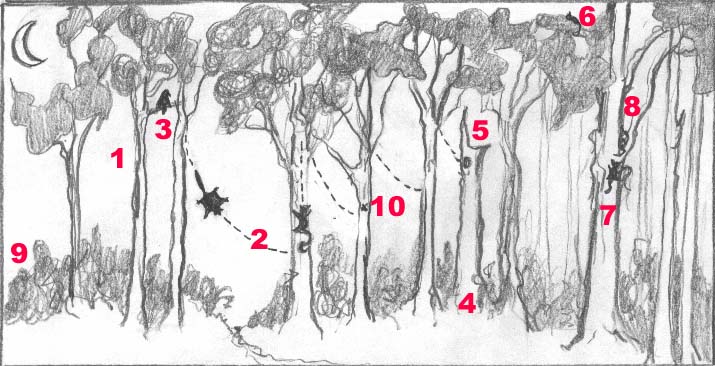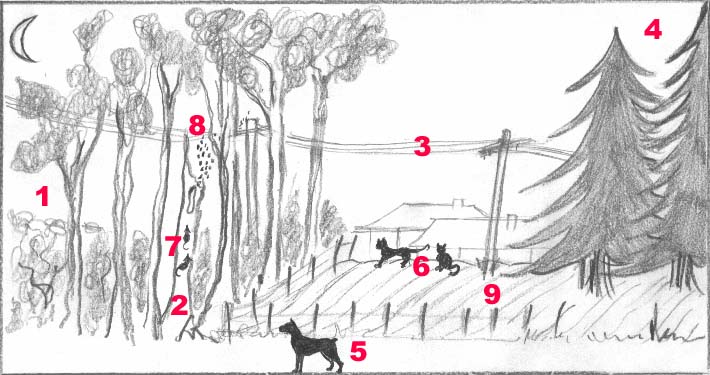|
Sugar Glider Species in Tasmania
Classification
| Genus |
Petaurus |
(Small Possum) |
| Family |
Petauridae |
|
| Species |
P. breviceps |
(Sugar Glider) |
| Subspecies |
Petaurus breviceps breviceps |
(Tasmania, NSW, VIC) |
This is the only sugar glider subspecies to inhabit Tasmania
- A native Australian marsupial mammal
- A protected species
- A vulnerable species in Tasmania
Habitat
Colonies can be found down the entire Eastern Seaboard of
our Australian Continent and have also been documented as
far west as Darwin and South Australia. The Sugar Glider is
arboreal (tree dwelling) and Tasmanian colonies are found
in most tall timber eucalypt stands in the North/ Northwest,
North East/ South & South East of the island, but predominantly
in the East & South East. The midlands of Tasmania have been
cleared for sheep farming for at least the last century and
temperatures in the South West are considered too inhospitable
for the sugar gliders food source During the day colonies
nest together in twig and gumleaf lined hollows in selected
communal nesting trees.
Social behaviour
Social behaviour is highly evident in the colonies where competitiveness
increases with age. Because there is safety in numbers they
nest together and share large prey meticulously fairly. They
constantly groom themselves and each other. The males can
become very domineering and may be ejected from the nest on
occasion to cool off - when this happens he will simply lever
the bark back in the fork of a tree and sleep in the fold
for a night or two. They approach the nest entrance slowly
so as not to alert predators and always select a hollow with
the smallest possible opening to prevent invasion.
Characteristics of the Tasmanian Sugar Glider
- An endearing member of the possum family barely 1cm in
length at birth
- Live together in social groups comprising one or more
families
- The young remain in the female's forwardly opening pouch
for 10 weeks
- Although there are four teats usually only two young survive
- When Joeys become too heavy they are suckled in the nest
until 15 weeks
- Young then graduate to mother's back and may stay with
the group for 2 seasons
- Average adult weight is approx.
- Average life expectancy in the wild is 4 to 5 years
- During bouts of extreme cold or when food is scarce they
become "torpid"
Identification
- Grey fur with a darker mid dorsal stripe and white underbelly
- Each gliders markings are unique.
- Female gliders dorsal stripes are thinner than the males'.
- Agile fingers (5 per paw) and claws for good tree grip
after gliding.
- Lengthy tail (barely prehensile) which acts as rudder
in flight
- Muscle controlled "wings" of membrane between limbs for
aerial gliding
- Large protruding eyes for enhanced night vision during
nocturnal activity
- Large erect ears for heightened hearing
- Short dense fur coat for optimum body heat regulation
- Long, strong tongue to gather nectar & drink tree sap
- Long, sharp rodent like teeth to strip bark and tap tree
gum and sap
- Fur fringe between claws for silent flight
- Darker band markings camouflage their flight in moonlight
- Timid yet capable of scratching and biting in self defence
Natural Predator
- The night owl is the gliders only natural predator in
Tasmania. It swoops on the glider in flight and snaps off
its tail, sending it plummeting to the ground, to become
easy prey. Glider tails are regularly spotted by bushwalkers.
New Predators and problems of the 1900's
- The cat - both feral and domestic
- The dog - both feral and domestic
- Increases in numbers of introduced European rat
- European wasps competing for tree hollows
- Rural land clearing robs them of feeding and breeding
sites
- Logging and wood chipping of old growth forest
- Monoculture tree plantations (non-flowering)
- Changing weather patterns have driven them into suburbia
The glider's ecosystem
Natural Habitat:

Key:
| 1. Tall Timber Eucalypt Coupe |
6. Tree canopy (food source) |
| 2. Glider Flight Path (up to 50m) |
7. Stripping bark (for insects) |
| 3. Owl, only natural predator (Tas.) |
8. Napping under bark. |
| 4. Nesting Tree |
9. Understory (Acacia or fern) |
| 5. Communal Nest (in tree hollow) |
10. Running sap score (food source) |
Habitat after human intervention:

Key:
| 1. Diminished tall timber stands |
6. Feral and domestic cats |
| 2. Reduced nesting hollows |
7. Introduced rat species |
| 3. Broken flight path |
8. European wasps |
| 4. Monoculture tree plantation |
9. Exposure due to land clearance |
| 5. Feral and domestic dogs |
|
|



